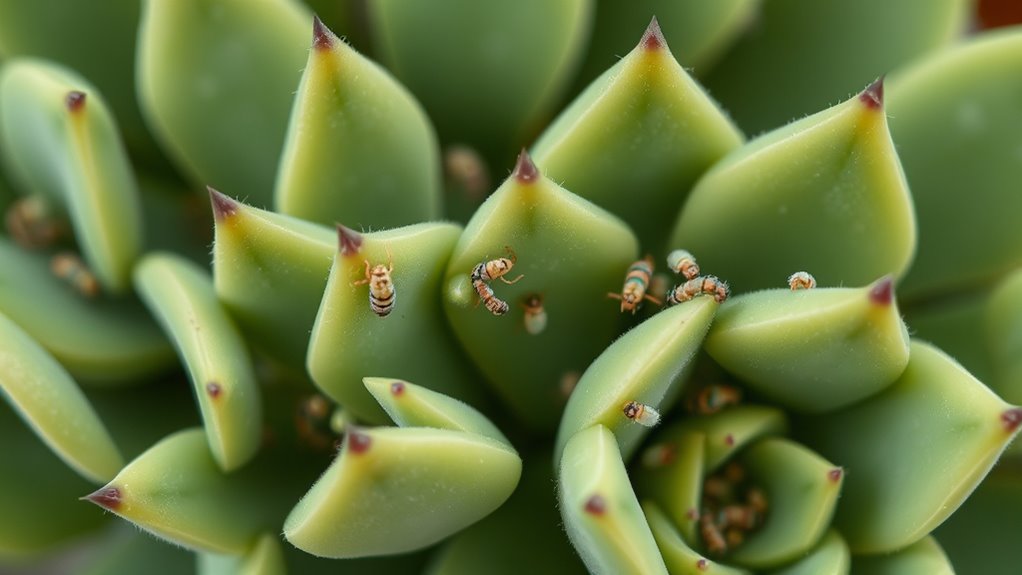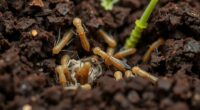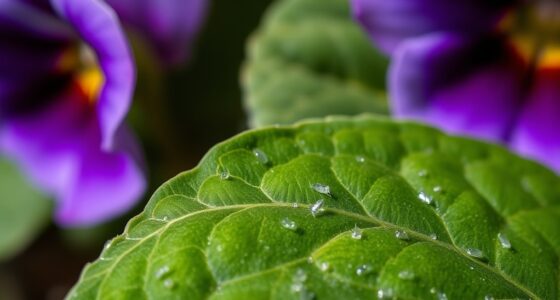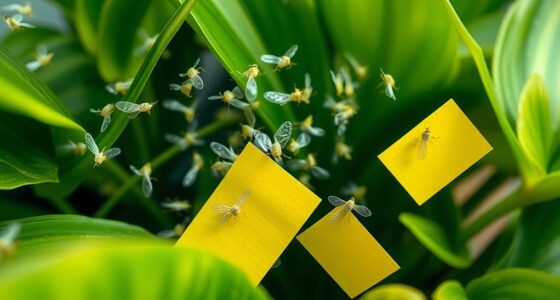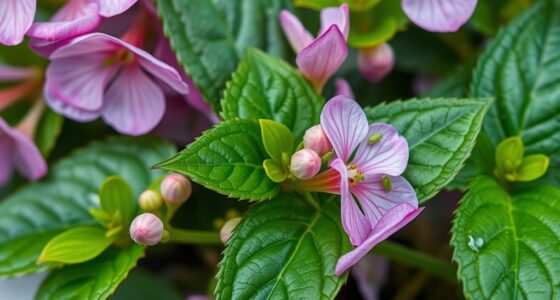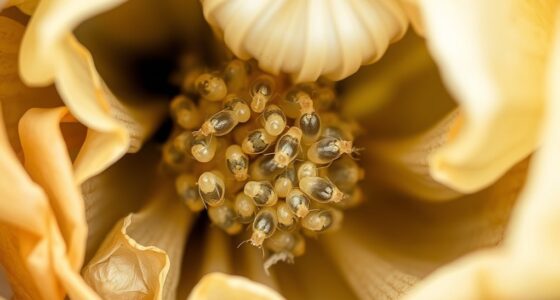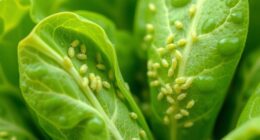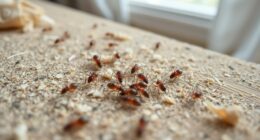To control mealybugs on your indoor succulents, start by carefully inspecting and isolating affected plants to prevent spreading. Manually remove pests with alcohol-dipped cotton swabs or cloths and spray the plants with neem oil or insecticidal soap following safety guidelines. Improve airflow, avoid overwatering, and keep plants healthy to make them less appealing to pests. For more detailed tips and prevention strategies, continue exploring effective methods to protect your succulents.
Key Takeaways
- Regularly inspect indoor succulents for white, cottony clusters and sticky honeydew to catch infestations early.
- Isolate affected plants immediately and use alcohol-dipped cotton swabs to manually remove mealybugs.
- Apply neem oil or insecticidal soap thoroughly on all plant surfaces, including undersides of leaves.
- Improve airflow and reduce humidity around plants to create less favorable conditions for pests.
- Maintain plant health with proper watering, well-draining soil, and organic fertilization to bolster pest resistance.
Identifying Mealybugs on Your Succulents
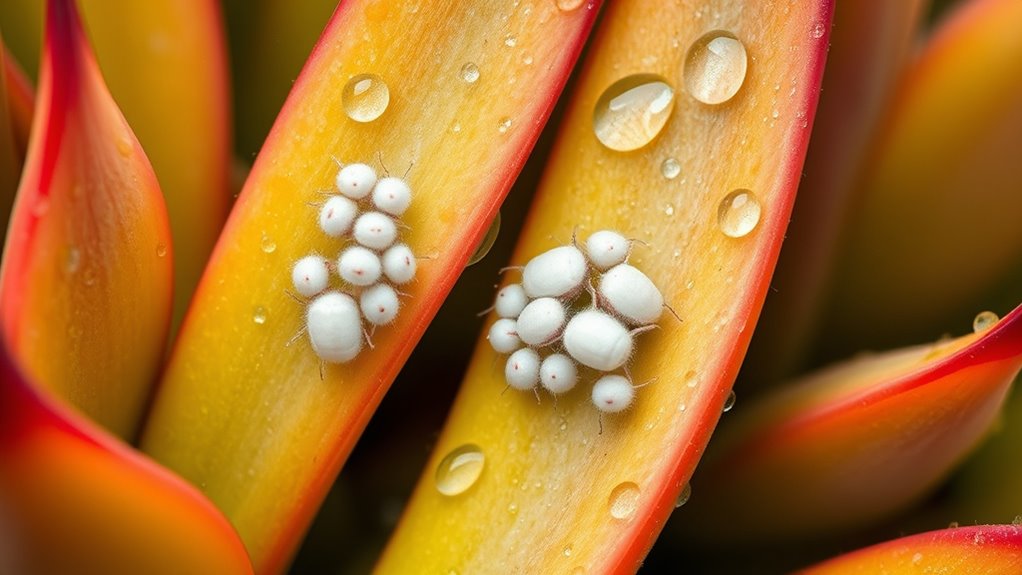
How can you tell if your succulents are infested with mealybugs? The key is careful mealybug identification through visual symptoms. Look closely at your plants, especially in hidden areas like leaf joints and the undersides. Mealybugs appear as small, white, cottony clusters that cling to the plant’s surface. They’re often mistaken for powdery residue, but their soft, fuzzy texture is a giveaway. You might also notice sticky honeydew on the leaves or nearby soil, signaling their presence. Regular inspection helps catch an infestation early. By recognizing these visual symptoms, you can act quickly to prevent the bugs from spreading further. Early detection is essential to keeping your succulents healthy and free of mealybugs. Maintaining proper filtration systems can also help reduce the spread of pests in indoor environments.
Isolating Infested Plants to Prevent Spread
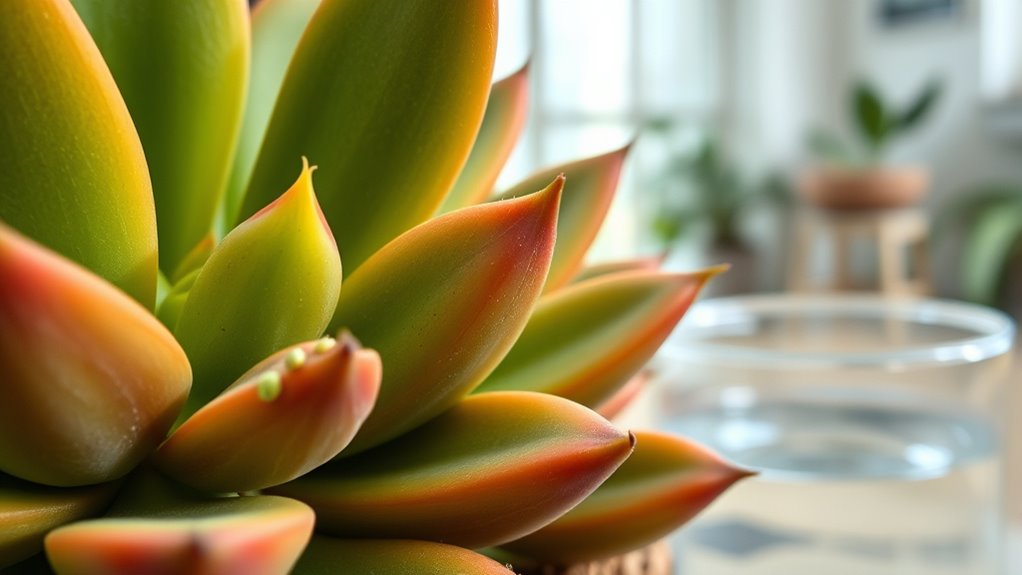
To prevent mealybugs from spreading, you should isolate infested plants immediately. Keep new or affected plants separate and use different tools for each to avoid cross-contamination. These simple steps help protect your healthy succulents from further infestation. Additionally, inspecting your tools and sprayers for any residual pests or eggs can prevent re-infestation, as proper equipment maintenance is essential for effective pest control.
Quarantine New Plants
Quarantining new plants before introducing them to your existing collection is essential for preventing the spread of mealybugs. When you bring a new succulent home, keep it isolated for at least a few weeks. During this time, perform plant repotting if needed, using sterilized soil to eliminate any hidden pests or eggs. Soil sterilization is vital—bake soil in the oven at 180°F for 30 minutes or use a microwave method—to kill mealybug eggs and larvae. Keep the quarantined plant in a separate area, away from your healthy succulents. Regularly inspect it for signs of pests, and avoid sharing tools or watering cans. This proactive step helps catch infestations early, protecting your entire collection from an outbreak.
Use Separate Tools
Using separate tools is an essential step in preventing mealybug spread among your succulents. When treating or pruning infested plants, always sterilize your tools before moving to healthy ones. Tool sterilization helps eliminate any lingering pests or eggs that could transfer to unaffected plants. Keep infested succulents isolated in pest-proof containers to avoid accidental contact with healthy plants. Using dedicated tools for each plant reduces the risk of cross-contamination. After working on an infested plant, thoroughly clean and disinfect your tools with alcohol or a bleach solution. This practice ensures no mealybugs hitch a ride to other plants. By maintaining clean tools and pest-proof containers, you create a safer environment for your succulents and considerably reduce the chance of spreading infestations.
Avoid Cross-Contamination
When you notice mealybugs on your succulents, isolating the affected plants is essential to prevent the infestation from spreading. Keep infested plants separate from healthy ones, and avoid sharing tools or pots. Consider soil sterilization to eliminate hidden pests and eggs, reducing reinfestation risk. Using pest-resistant varieties can also minimize future issues. To further prevent cross-contamination:
- Regularly disinfect gardening tools and containers
- Quarantine new or affected plants before introducing them to your collection
- Opt for pest-resistant succulent varieties when possible
- Predictive analytics can help identify early signs of pest outbreaks, enabling proactive management.
Manual Removal Techniques for Mealybugs
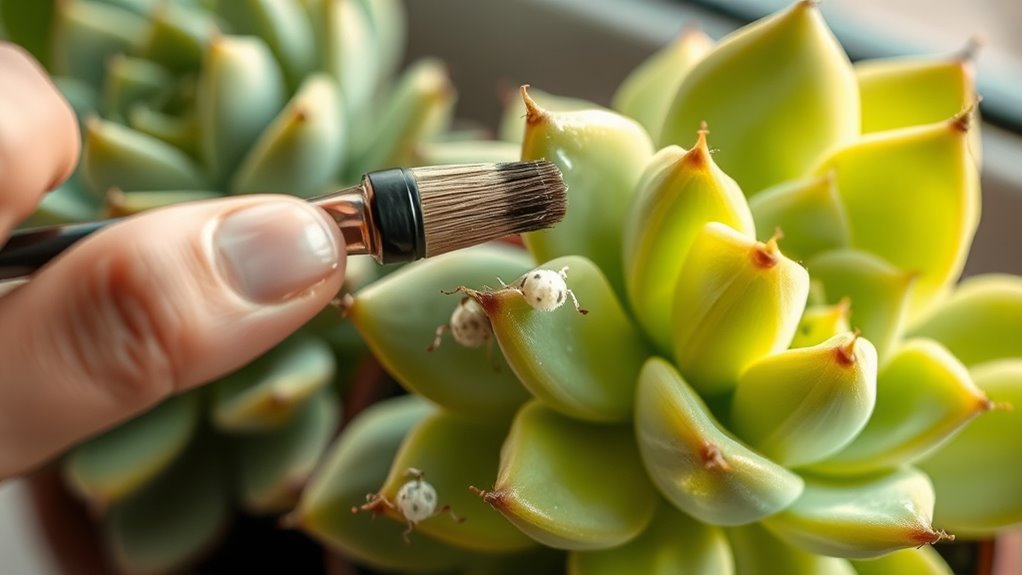
Manual removal is an effective first step in controlling mealybugs on your succulents. Carefully inspect each plant and gently rub or wipe off visible pests with a soft cloth or cotton swab dipped in alcohol. This immediate action reduces the pest population and prevents them from spreading further. To enhance effectiveness, combine manual removal with environmental adjustments like increasing airflow and reducing humidity, which make your succulents less inviting to mealybugs. While manual methods don’t eliminate all pests, they help keep infestations manageable. For persistent issues, consider integrating biological controls such as introducing natural predators later on. Regularly inspecting your plants and promptly removing pests is key to maintaining healthy, mealybug-free succulents indoors. Embracing Calm and Clarity through consistent care helps you maintain resilience against pest challenges.
Using Natural Remedies to Eliminate Mealybugs

After removing visible mealybugs, natural remedies can help further reduce any remaining pests and prevent new infestations. You can use plant-based solutions like neem oil or insecticidal soap, which target pests without harming your succulents. Additionally, implementing companion planting can deter mealybugs; plant herbs like basil or marigolds nearby. Soil amendments such as organic compost or diatomaceous earth strengthen your succulents’ health, making them less attractive to pests. These strategies promote a balanced environment and reduce reliance on chemicals. Understanding contrast ratio is also important, as healthy, vibrant plants with good contrast can be less appealing to pests. Remember, consistent application and observation are key to success. By integrating these natural remedies, you create a healthier, pest-resistant setup that keeps your succulents thriving indoors.
Applying Insecticidal Soaps Safely

Applying insecticidal soaps safely is essential to protect your succulents while effectively controlling mealybugs. Always spray early in the morning or late afternoon to avoid harming beneficial insects and prevent leaf burn. Use organic pesticides responsibly, ensuring thorough coverage of all affected areas. Avoid spraying when temperatures are high, as this can damage your plants. To minimize impact on beneficial insects, target only infested parts of the plant. Keep pets away during application and wash your hands afterward. Properly stored insecticidal soap remains effective longer. Being aware of plant health management strategies can further enhance your pest control efforts. Here’s a quick overview:
| Step | Action | Tip |
|---|---|---|
| 1 | Spray in the morning/evening | Avoid harsh sunlight |
| 2 | Cover all infested areas | Ensure thorough coverage |
| 3 | Minimize impact on beneficial insects | Spray selectively |
| 4 | Store properly | Maintain effectiveness |
Incorporating Neem Oil for Pest Control
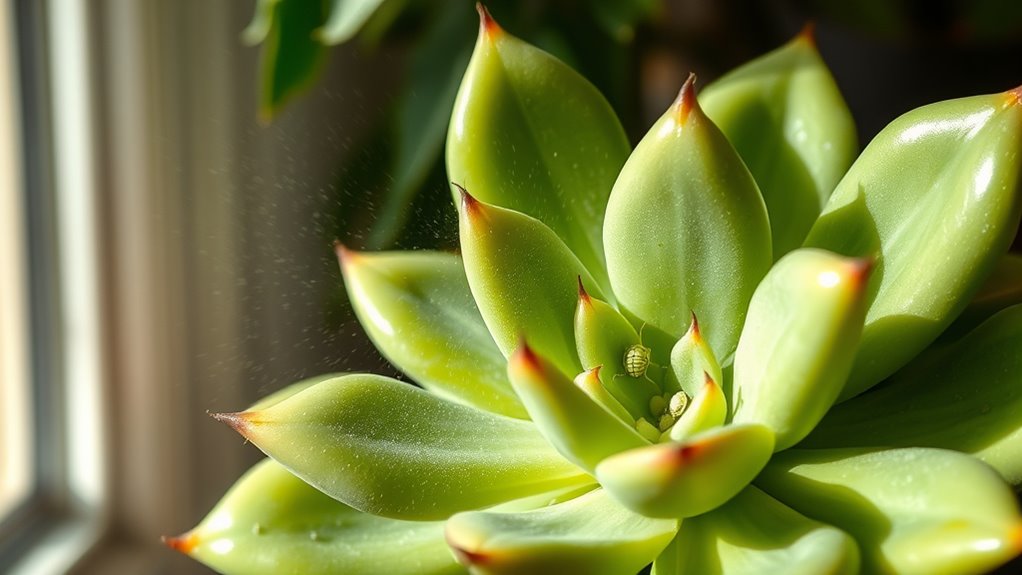
Neem oil is a natural and effective option for controlling mealybugs on succulents. To get the best results, you should follow proper application techniques and take safety precautions. Let’s explore how to use neem oil effectively and safely in your pest management routine. When using essential oils like neem oil, always dilute them appropriately to avoid skin irritation or plant damage; dilution guidelines are essential for safe application.
Neem Oil Effectiveness
Neem oil is widely recognized as a natural and effective solution for controlling mealybugs on succulents. Its effectiveness depends on consistent application and proper timing. When you incorporate neem oil into your pest control routine, it helps disrupt the pests’ lifecycle and reduces infestations. To maximize results, consider adjusting your soil amendments and watering schedules, as healthy, well-drained soil promotes stronger plants resistant to pests. Regularly inspecting your succulents ensures early detection and treatment. Keep in mind that neem oil works best when you:
- Apply it during cooler parts of the day to prevent leaf burn
- Use it as part of a holistic approach, including soil amendments
- Maintain proper watering schedules to reduce stress on plants
- Incorporate integrated pest management practices to enhance overall plant health
This approach enhances neem oil’s efficacy and keeps your succulents healthier.
Application Techniques
To effectively control mealybugs on your succulents, proper application techniques are key. Start by gently lifting the plant to access all infested areas. Mix neem oil according to the instructions, ensuring thorough coverage of the affected parts. Spray the solution evenly, making sure to coat the undersides of leaves and stem crevices where pests hide. Improving soil aeration helps prevent excess moisture that attracts mealybugs and promotes healthy root development. Adjust your watering frequency so you don’t overwater, which can create a favorable environment for pests. Apply neem oil early in the day or late in the afternoon when temperatures are cooler. Reapply every 7 to 10 days until the infestation subsides. Consistent treatment combined with proper watering and soil care will effectively reduce mealybug populations. Additionally, maintaining appropriate lighting conditions can help strengthen your succulents against pests and diseases.
Safety Precautions
While neem oil is an effective natural pest control method, it’s important to handle it with care to guarantee your safety and that of your plants. Always wear gloves and eye protection when spraying neem oil to avoid skin or eye irritation. Use garden lighting in well-ventilated areas to prevent inhaling fumes. Be cautious with soil amendments; avoid over-application, which can harm roots and reduce plant health. Additionally, understanding the Bitcoin IRA market can help you make more informed decisions about your investment strategies. Remember:
- Store neem oil away from children and pets.
- Test a small area of your succulent before full application.
- Keep your workspace clean to prevent accidental ingestion or exposure.
Enhancing Plant Health to Resist Infestation
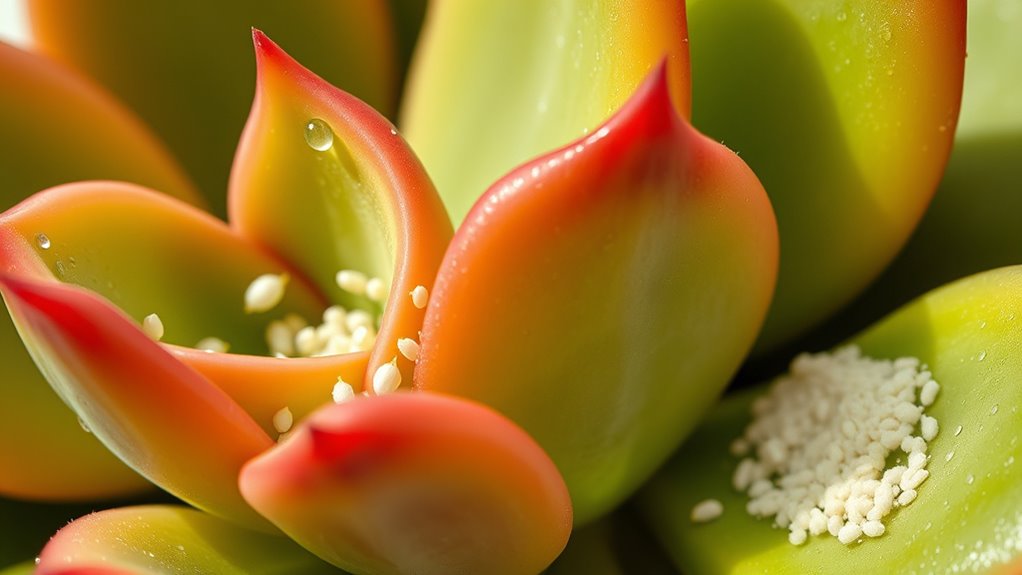
Healthy succulents are better equipped to withstand mealybug infestations, so focusing on strengthening their overall vigor is essential. To do this, prioritize soil health management by using well-draining soil and avoiding overwatering. Incorporate beneficial companion plants, like herbs or low-maintenance greenery, to promote a balanced environment that discourages pests. This combined approach boosts your plant’s resilience naturally.
| Benefit | Explanation |
|---|---|
| Improved soil structure | Enhances root health and nutrient uptake |
| Natural pest deterrence | Companion plants repel or confuse pests |
| Increased plant vigor | Stronger plants resist infestations better |
| Balanced ecosystem | Reduces pest outbreaks and promotes growth |
| Reduced chemical use | Less reliance on pesticides, safer environment |
Regular Monitoring and Maintenance Practices
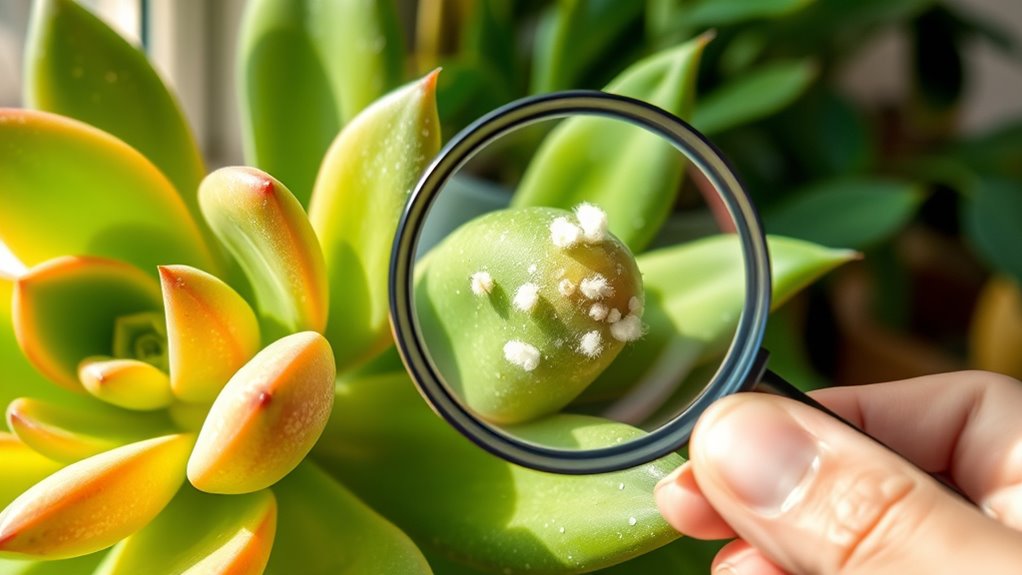
How often should you check your succulents? Ideally, you should inspect them weekly for signs of mealybugs or stress. Regular monitoring helps you detect issues early, making treatment easier. During each check, focus on soil aeration to ensure roots aren’t waterlogged, which can attract pests. Maintain a consistent fertilization schedule to promote healthy growth and resilience.
To keep your succulents thriving, remember:
- Rotate your plants to check all sides for pests and damage
- Loosen and aerate the soil to improve drainage and prevent pest hiding spots
- Adjust fertilization based on plant needs, avoiding overfeeding that can weaken plants
Consistent care helps prevent infestations and keeps your succulents healthy.
Preventative Measures to Avoid Future Infestations
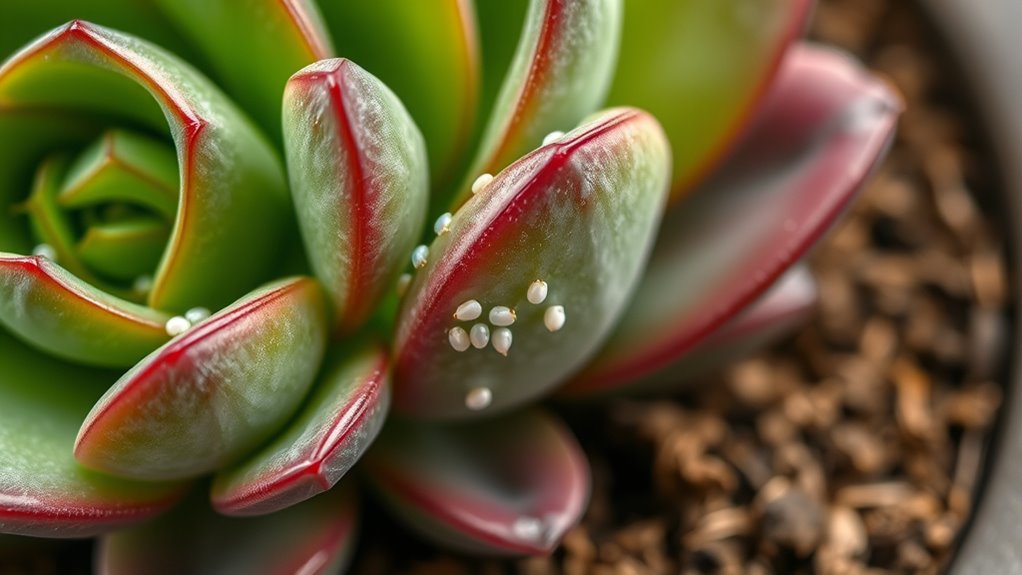
Regularly inspecting your succulents helps catch problems early, but taking proactive steps can prevent mealybugs from ever taking hold. Start by maintaining healthy plants through proper watering, drainage, and sunlight. Introduce beneficial insects like ladybugs or lacewings to naturally deter pests. Using organic pesticides as a preventive measure can also help keep mealybugs at bay.
| Preventative Step | Purpose |
|---|---|
| Quarantining new plants | Stops pests from spreading to healthy succulents |
| Regularly inspecting & cleaning | Detects early signs and removes debris or pests |
| Using organic pesticides | Creates a pest-resistant environment |
| Encouraging beneficial insects | Natural pest control without chemicals |
These strategies create a pest-resistant environment, safeguarding your succulents.
When to Seek Professional Pest Control Assistance
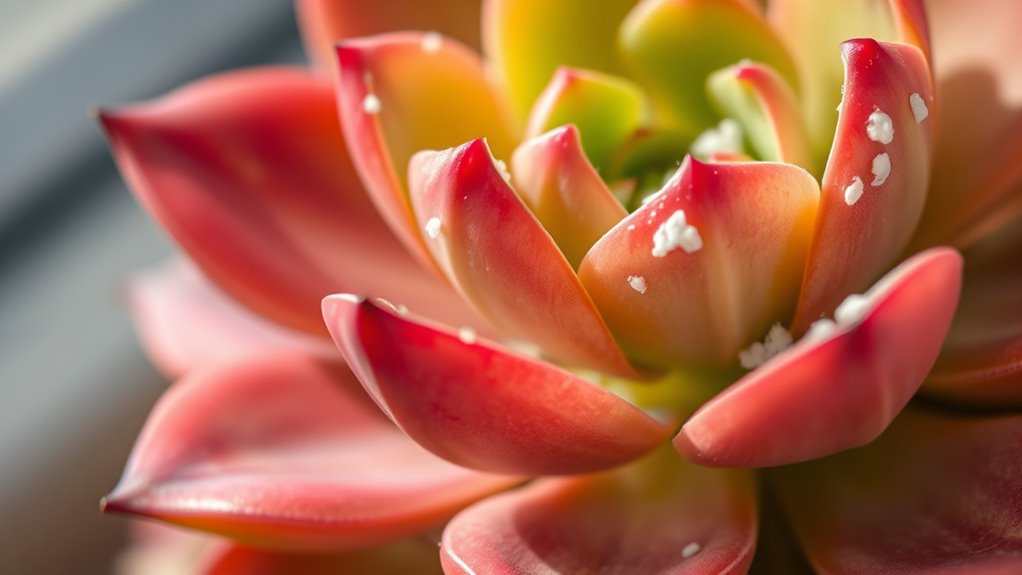
Recognizing when to call in a professional pest control service is crucial, especially if your efforts to manage mealybugs haven’t yielded results. If you’ve adjusted plant nutrition and watering schedules but still see persistent infestations, it’s time to seek expert help. Professionals can effectively target hidden pests and prevent further damage. Consider reaching out if:
When persistent mealybug infestations occur despite adjustments, it’s time to call in a professional pest control service.
- Mealybugs spread despite improved watering and nutrition
- Infestation causes visible plant stress or decay
- You’re unsure how to safely treat delicate succulents
Professional pest control can also address underlying issues, ensuring your plants recover fully. Remember, early intervention saves your plants and minimizes chemical use. Don’t hesitate to seek help if your DIY efforts stall, especially when the health of your succulents is at stake.
Frequently Asked Questions
Can Mealybugs Harm Only Succulents or Other Houseplants Too?
Mealybugs don’t just target succulents; they can also harm other houseplants. To prevent infestations, practice pest prevention by inspecting your plants regularly and maintaining good plant hygiene. Removing dead leaves and debris helps reduce hiding spots for pests. If you spot mealybugs early, act quickly to control them, protecting your entire indoor garden. Consistent care keeps your plants healthy and less vulnerable to these pesky pests.
Are There Specific Succulents More Prone to Mealybug Infestations?
Like moths to a flame, some succulents are more prone to mealybug infestations. You’ll notice that pest-prone species, such as Echeveria and Sedum, have higher succulent susceptibility. These plants often have tender, exposed tissues that make them easier targets. To protect your collection, keep a close eye on these species, and act quickly at the first sign of pests to prevent widespread damage.
How Long Does It Take for Natural Remedies to Work?
Natural remedy effectiveness varies, but you typically see results within a week or two. Keep in mind, some pests develop resistance, making natural solutions less effective over time. To combat this, regularly apply treatments like neem oil or insecticidal soap, and monitor your succulents closely. Consistent use enhances pest resistance management, ensuring your plants stay healthy. Patience and persistence are key for natural remedies to work effectively.
Can Overwatering Attract Mealybugs to Succulents?
Imagine you overwater your succulents regularly, and soon, mealybugs appear. Overwatering can attract mealybugs because moist soil creates an ideal environment for them to thrive. Your watering habits directly influence soil moisture, which can draw these pests. To prevent this, let the soil dry out between waterings and avoid excess moisture. Proper watering reduces the risk of mealybug infestations and keeps your succulents healthy.
What Are the Signs of a Severe Mealybug Infestation?
A severe mealybug infestation shows clear plant damage symptoms like yellowing, stunted growth, and soft, rotting spots. You’ll notice a cotton-like residue and tiny insects clustered on your succulent’s roots or leaves. Understanding the mealybug lifecycle helps you identify early stages, but when infestation is severe, these signs become widespread, and the plant’s health declines rapidly. Act quickly to prevent further damage and control the spread.
Conclusion
By staying vigilant and acting swiftly, you can keep mealybugs at bay and ensure your succulents thrive. Regular checks and gentle remedies work wonders, much like a skilled healer of old. Remember, prevention is your best armor—so don’t wait until it’s too late. With patience and persistence, you’ll enjoy healthy, pest-free plants, proving that even in this modern age, a little old-fashioned care can go a long way.
